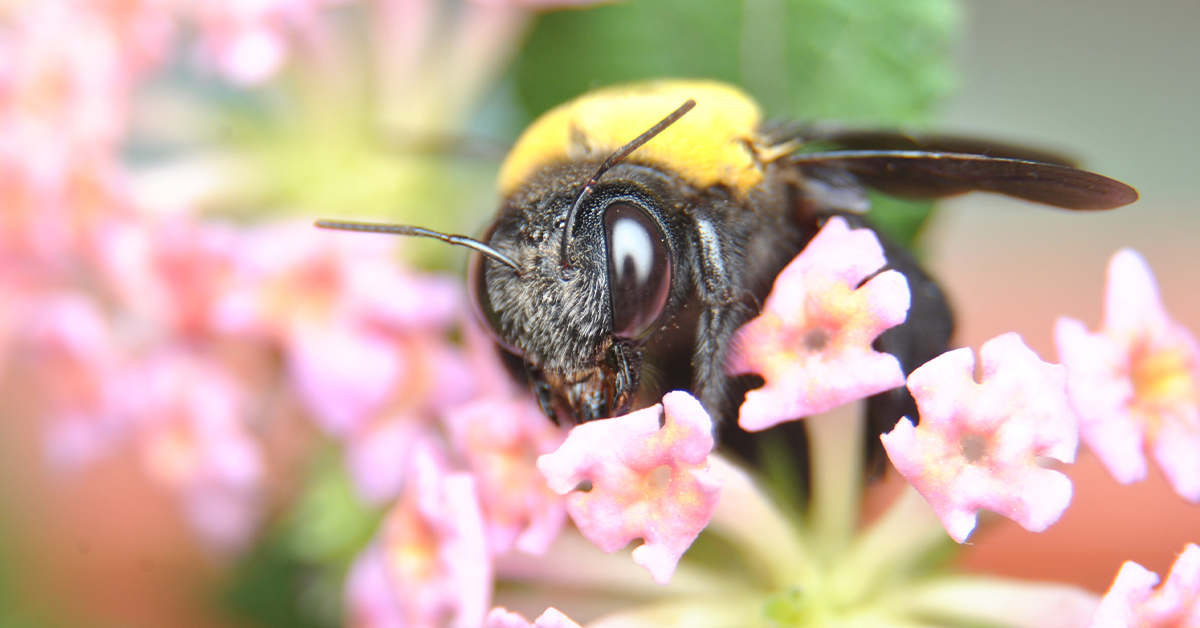Not all bees are created equal. Most happily pollinate plants, make honey, and play their crucial role in the food chain. Others, however, may wreak havoc by being aggressive or destructive. Two rather “friendly” species you may encounter are carpenter bees and bumblebees.
Is that a Carpenter Bee or Bumble Bee?
These large bees are similar in appearance, but they have a few key differences. Bumblebees are fuzzy with yellow markings, where carpenter bees have shiny, bare abdomens and characteristic black circles on their thorax.
There are some behavioral differences as well. Bumblebees tend to fly in a straight line, while carpenter bees change directions often – appearing to dive, dash, and chase each other. Bumblebees live in large underground colonies and are highly social. Carpenter bees are significantly less communal, with single bees nesting in holes bored into wood. Their hole-boring behavior is the reason why this cute, otherwise harmless species may not be welcome near your home.
Why Do Carpenter Bees Bore Holes?
Female carpenter bees bore into wood to build nests where they lay their eggs and guard the developing larvae. Carpenter bees are capable of boring into hardwood, but most species tend to choose old, soft, damp, and/or unpainted wood, simply because it takes less effort.
How Do Carpenter Bees Make Holes?
Female carpenter bees have extremely strong mandibles that move in a circular motion. These powerful jaws drill round holes into wood surfaces, in the direction of the wood’s grain – the path of least resistance.
After boring into a piece of wood, they may drill additional tunnels off the main opening. They are capable of drilling an inch into the wood every five days. Over time, this adds up and can seriously compromise the structure in which they’ve taken up residence.
Carpenter bee tunnels are usually hidden from view, and the only evidence you may see is the initial opening on a wood surface. These holes are perfectly round and approximately ⅜” in diameter. There may also be a sawdust-like substance outside the hole, which is a combination of wood dust and bee waste.
Do Carpenter Bees Have a Queen?
Unlike their bumblebee and honeybee cousins, carpenter bees don’t have queen and worker roles. Instead of living in large colonies, these bees live in small family groupings.
Are Carpenter Bees Dangerous?
Carpenter bees aren’t particularly dangerous to people or pets. Females may sting if they perceive a threat, but they don’t attack in swarms like some stinging insects. Male carpenter bees don’t even have stingers. They may act aggressively, flying toward humans or domestic animals, but they are all bravado and no sting.
They pose a low direct risk to most people and pets, but carpenter bee incursions can cause structural damage to your home, deck, outbuildings, and wood furniture. In addition to undermining the integrity of wood by drilling holes, carpenter bee nests attract woodpeckers that can chip away at wood when they attempt to access bee larvae – one of their favorite meals. Further damage occurs when rainwater and other moisture enter bee tunnels, softening the wood and speeding rot.
Twin Forks Pest Control® Is Your Carpenter Bee Removal Expert
Because their damage can become highly destructive over time, it is important to remove carpenter bees as soon as their presence is detected. Twin Forks Pest Control® is here to evict these unwanted visitors and to prevent further property damage. We are your East End Long Island pest specialist, with more than two decades of experience in locating and removing pests in your home and yard. Call us today for a free estimate.

